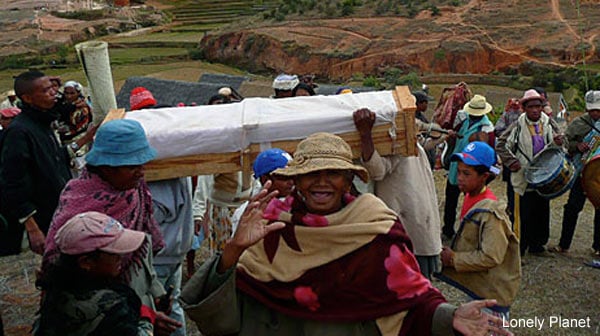Turning of the bones and the Madagascar dance with the dead
The Malagasy people of Madagascar have built a way of life around death – during the dry winter months, famadihana ceremonies, known as “the turning of the bones”, take place around various towns and villages to commemorate the deceased.
Once every two to seven years, each family holds a huge celebration at their ancestral crypt where the remains of the dead are exhumed, wrapped in fine silk, sprayed with wine or perfume, and brought out for community festivities. In the Malagasy culture, the turning of the bones is a vital element in maintaining links with revered ancestors, who still play a very real role in daily life.
Anthropologist Professor Maurice Bloch, who has studied the ritual, says the ceremony is a chance for a family reunion. It is an evocation of being together again, a transformation so that the dead can experience once more the joys of life. But most importantly, he says, famadihana is an act of love.
As one foreigner who witnessed the ceremony described, “I came expecting the most macabre of ceremonies but instead found an extreme form of adoration for loved ones that will forever change how I view life and death”.
The custom is based upon a belief that the spirits of the dead do not join the superior world of the ancestors until after the body has decomposed completely, and until that time, the spirit of the deceased still lingers and is able to communicate with the living. Until they are gone forever, the festivities of famadihana are a way to shower love and affection upon them.
Death is not a sad occasion for many Malagash, but a time for celebrating. It is believed that the ancestors, like everyone, appreciate a really good party, especially one held in their honour.
The rituals of famadihana
Family members come from far and wide to attend the famadihana, sometimes traveling entire days on foot to attend the two-day festivities. When everyone has gathered, the corpses are delicately pulled from the tomb or crypt and wrapped in straw floor mats. Groups of people heave the corpses above their heads and carry them off, before laying them side-by-side on the ground to be cleaned and dressed. Their dried burial garments are delicately pulled from their corpses and the bodies are dressed in fresh silk garments. Women who are having trouble conceiving will take fragments of an ancestor's old shroud and place them under their mattresses (or even eat them) to induce pregnancy.

Old garments are carefully removed from the bodies. Photo credit.
Following the dressing of the deceased, a great party is held with music, dancing, and a huge feast among the villagers. As a band plays at the lively event, family members dance with the bodies. For some, it’s a chance to pass family news to the deceased and ask for their blessings — for others, it’s a time to remember and tell stories of the dead.
When the festival ends, the bodies must be returned to the tomb as the sun slowly retires beyond the horizon. They are re-buried alongside gifts of money and alcohol and placed upside-down to close the cycle of life and death. After a final ritual cleaning, the tomb is immediately closed - a powerful and emotional moment, embodying all the spiritual richness of the previous days' celebrations.
The rituals show some similarity to the ritual of Ma’Nene carried out by the Tana Toraja in South Sulewsi, a festival in which mummified bodies are exhumed by family members, washed, dressed in fresh clothes and walked through the village.
Famadihana Today
The ritual of famadihana is on the decline due to the expense of the celebrations and opposition from some Christian organisations. Conducting the celebrations are a costly affair which involve elaborate preparations including meals to feed hundreds of guests, and expensive silk shrouds to wrap up the deceased. Some of the poor do not have family crypts, so they save up for several years to be able to build one, and then hold a festival for their own dead ancestors. The Malagasy people believe that no dwelling for the living should be as substantial and costly as the tombs which house the dead, and the money spent on keeping the ancestors happy is more than any family member would dream of spending on themselves.
There has been increasing opposition in Madagascar from Evangelical Protestants who discourage the custom, although the Catholic Church no longer objects because it regards famadihana as purely cultural rather than religious.
Travel writer Hilary Bradt, who has attended the famadihana celebrations, has described the meaning she ascribed to these unique rituals: “In our culture there is no mechanism to ensure that, years after their passing, we continue to remember the dead. Yes, we honour their memory and lay flowers on their graves, but as a solitary act. The bone-turning ceremony is a collective expression of respect and love”.
Featured image: Famadihana festivities. Photo credit.
Related Videos
Watch Video of the famadihana celebrations
References
Turning the Dead: Famadihana in Madagascar – Lonely Planet
Dancing With Corpses: A Rare Look Inside the World’s Most Bizarre Ceremony – MyWanderlist
Turning of the Bones – by Hilary Bradt
Madagascar: Exhumation Ceremonies – Travel Africa Mag



















